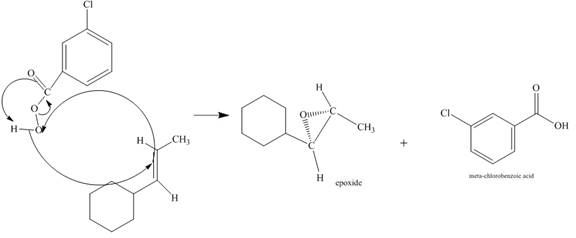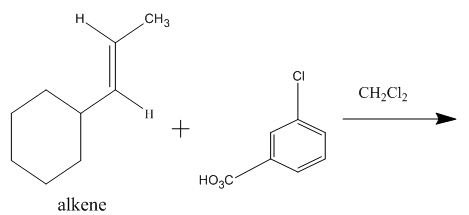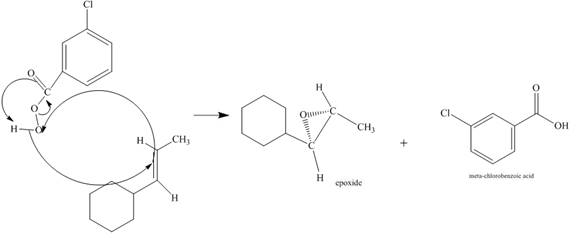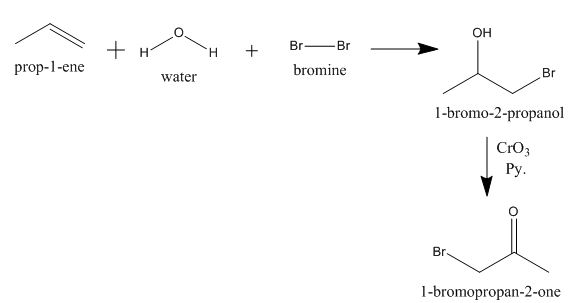
(a)
Interpretation:
The given reaction is to be completed with principal organic products.
Concept introduction:
The replacement or substitution of one
Answer to Problem 11.60AP
The completed given reaction is shown below.

Explanation of Solution
The incomplete given reaction is shown below.
The oxygen atom of sodium ethoxide can act as a nucleophile and attack the carbon atom of

Figure 1
The completed given reaction is shown in Figure 1.
(b)
Interpretation:
The given reaction is to be completed with principal organic products.
Concept introduction:
Substitution reaction is a type of reaction in which an atom or group of atoms is replaced or substituted by another atom or group of atoms. An elimination reaction is a type of reaction in which two atoms are eliminated in the presence of solvent. Elimination reactions are usually favored in the alcoholic conditions.
Answer to Problem 11.60AP
The completed given reaction is shown below.

Explanation of Solution
The incomplete given reaction is shown below.

Figure 2
The given

Figure 3
The completed given reaction is shown in Figure 3.
(c)
Interpretation:
The given reaction is to be completed with principal organic products.
Concept introduction:
Oxymercuration reaction is a type of reaction in which an alkene gets converted to alcohol. The mercuric acetate is used in the reaction as a reagent. This reagent attacks the alkene to form a cyclic intermediate compound which further undergoes reduction to form alcohol.
Answer to Problem 11.60AP
The completed given reaction is shown below.

Explanation of Solution
The incomplete given reaction is shown below.

Figure 4
The mercuric acetate
The corresponding chemical reaction is shown below.

Figure 5
The completed given reaction is shown in Figure 5.
(d)
Interpretation:
The given reaction is to be completed with principal organic products. The stereochemistry of the product is to be predicted.
Concept introduction:
An
Answer to Problem 11.60AP
The completed given reaction is shown below.

Explanation of Solution
The incomplete given reaction is shown below.

Figure 6
The alkene attacks on the peroxide linkage of the given percarboxylic acid to form an epoixde ring with elimination of carboxylic acid. The oxygen atom of the epoxide will be pointed inwards that is into the plane of the molecule. The corresponding chemical reaction is shown below.

Figure 7
The completed given reaction is shown in Figure 7.
(e)
Interpretation:
The given reaction is to be completed with principal organic products.
Concept introduction:
The addition of one or more than one halogen atom in an alkene is known as halogenation reaction. The pathway of the halogenation reaction depends on the structure of the substrate. In this, the halogen is added to
The compound chromium
Answer to Problem 11.60AP
The completed given reaction is shown below.

Explanation of Solution
The incomplete given reaction is shown below.
The propene molecule undergoes halohydrin reaction with bromine gas in the presence of water molecule to form bromine substituted alcohol. The alcohol gets oxidized by

Figure 8
The completed given reaction is shown in Figure 8.
(f)
Interpretation:
The given reaction is to be completed with principal organic products.
Concept introduction:
The periodic acid acts as a strong oxidizing agent. The periodic acid reacts with a vicinal diol to form two aldehyde after breaking the carbon-carbon bond between the vicinal diol. The gem diol does not react with periodic acid as vicinal diol.
Answer to Problem 11.60AP
The completed given reaction is shown below.

Explanation of Solution
The incomplete given reaction is shown below.

Figure 9
The epoxide is converted into gem diol after the addition of water in it. The gem diol gets converted into two different aldehydes after breaking the bond between carbon atoms attached to the hydroxyl group. The corresponding chemical reaction is shown below.

Figure 10
The completed given reaction is shown in Figure 10.
(g)
Interpretation:
The given reaction is to be completed with principal organic products. The stereochemistry of the product is to be predicted.
Concept introduction:
Potassium permanganate is a strong oxidizing agent. Potassium permanganate can oxidize an alkene into alcohol. It can also oxidize an alcohol into carbonyl compound and the carbonyl compound can be further oxidized to form a carboxylic acid.
Answer to Problem 11.60AP
The completed given reaction is shown below.

Explanation of Solution
The incomplete given reaction is shown below.

Figure 11
The oleic acid reacts with alkaline

Figure 12
The completed given reaction is shown in Figure 12.
(h)
Interpretation:
The given reaction is to be completed with principal organic products. The stereochemistry of the product is to be predicted.
Concept introduction:
Epoxides undergo nucleophilic ring-opening reactions which are acid-catalyzed. If the epoxide is unsymmetrical, then the anionic nucleophile will attack the less-hindered carbon atom of the ring. If the reaction conditions are basic or neutral, then the reaction will occur at the less substituted carbon atom.
Answer to Problem 11.60AP
The completed given reaction is shown below.

Explanation of Solution
The incomplete given reaction is shown below.

Figure 13
The compound epoxide undergoes ring-opening reaction in the presence of sodium azide. The azide ion acts a nucleophile and attacks on the carbon atom of the epoxide ring to from final compound. The corresponding chemical reaction is shown below.

Figure 14
The completed given reaction is shown in Figure 14.
(i)
Interpretation:
The given reaction is to be completed with principal organic products.
Concept introduction:
Epoxides undergo nucleophilic ring-opening reactions which are acid-catalyzed. If the epoxide is unsymmetrical, then the anionic nucleophile will attack the less-hindered carbon atom of the ring. If the reaction conditions are acidic, then the reaction will occur at the more substituted carbon atom.
Answer to Problem 11.60AP
The completed given reaction is shown below.

Explanation of Solution
The incomplete given reaction is shown below.

Figure 15
The ether undergoes ring-opening reaction in the presence of acid. The dilithium dimethylcyanocuprate molecule generates a nucleophile

Figure 16
The completed given reaction is shown in Figure 16.
(j)
Interpretation:
The given reaction is to be completed with principal organic products.
Concept introduction:
The replacement or substitution of one functional group with another different functional group in any chemical reaction is termed as a substitution reaction. In a nucleophilic substitution reaction, nucleophile takes the position of leaving group by attacking the electron-deficient carbon atom.
Answer to Problem 11.60AP
The completed given reaction is shown below.

Explanation of Solution
The incomplete given reaction is shown below.
The compound

Figure 17
The completed given reaction is shown in Figure 17.
(k)
Interpretation:
The given reaction is to be completed with principal organic products.
Concept introduction:
The replacement or substitution of one functional group with another different functional group in any chemical reaction is termed as a substitution reaction. In a nucleophilic substitution reaction, nucleophile takes the position of leaving group by attacking on the electron-deficient carbon atom.
Answer to Problem 11.60AP
The completed given reaction is shown below.

Explanation of Solution
The incomplete given reaction is shown below.

Figure 18
The replacement of the hydroxyl group is not easy. Therefore, alcohol is first converted into tosylate ester with the help of tosyl chloride. The tosylate ester group is then substituted with

Figure 19
The completed given reaction is shown in Figure 19.
Want to see more full solutions like this?
Chapter 11 Solutions
Organic Chemistry Study Guide and Solutions
- Answe Answer A and B pleasearrow_forward3. Refer to the data below to answer the following questions: Isoelectric point Amino Acid Arginine 10.76 Glutamic Acid 3.22 Tryptophan 5.89 A. Define isoelectric point. B. The most basic amino acid is C. The most acidic amino acid is sidizo zoarrow_forward3. A gas mixture contains 50 mol% H2 and 50 mol% He. 1.00-L samples of this gas mixture are mixed with variable volumes of O2 (at 0 °C and 1 atm). A spark is introduced to allow the mixture to undergo complete combustion. The final volume is measured at 0 °C and 1 atm. Which graph best depicts the final volume as a function of the volume of added O2? (A) 2.00 1.75 Final Volume, L 1.50 1.25 1.00 0.75 0.50 0.25 0.00 0.00 0.25 0.50 2.00 (B) 1.75 1.50 Final Volume, L 1.25 1.00 0.75 0.50- 0.25 0.00 0.75 1.00 0.00 0.25 Volume O₂ added, L 2 0.50 0.75 1.00 Volume O₂ added, L 2 2.00 2.00 (C) (D) 1.75 1.75 1.50 1.50 Final Volume, L 1.25 1.00 0.75 0.50 Final Volume, L 1.25 1.00 0.75 0.50 0.25 0.25 0.00 0.00 0.00 0.25 0.50 0.75 1.00 0.00 0.25 Volume O₂ added, L 0.50 0.75 1.00 Volume O₂ added, L 2arrow_forward
- Leucine is an essential amino acid with the systematic name 2-amino-3-methylpentanoic acid. It has pai 2.36 and pKa2 = 9.60. H2N-C(R)H-COOH and R is -CH2-CH(CH3)2 A. Draw the condensed structure for leucine, and label all chirality centers with an asterisk. B. How many possible stereoisomers of leucine are there? C. Draw a Fischer projection of L-leucine and label the chirality center(s) as R or S. D. What is the p/ of leucine? E. Draw the structure of the predominant form of leucine at 10.00. F. Draw the structure of the predominant form of leucine at pH = 1.50. G. Leucine is described as an essential amino acid. What does this mean? H. Show the alkyl halide you would use to prepare leucine by the amidomalonate method. =arrow_forwarda) Write out 6 completely different reactions of acetophenone (reagent, product). b) Write out 3 preparations of 1-methylcyclohexanol, using a different starting material for each one. You may use preps where you just change the functional group, and/or preps where you construct the carbon chain. c) Write out 3 preparations of 2-ethoxybenzoic acid, a different starting material for each one. You may use preps where you just change the functional group, and/or preps where you construct the carbon chain.arrow_forward12. CH3 OH OH H&C CH3 H₂C N OH H₂C CH3 H&C CH3 H₂C' CH3 H.C CH3OH H.C CH2CH3OH CH3CEN Which one of these 17 compounds is represented by this IR and this 'H NMR spectrum? IR Spectrum 3000 4000 3000 NMR Spectrum 2000 £500 RAVENUMBER 2000 1500 9 8 6 5 10 HP-00-290 ppm m 1000 500 1000 4 °arrow_forward
- Draw the structure of (E,6R) 6-methoxy-4-hepten-2-one. Give the IUPAC name of this compound, including stereochemistry. Draw the most stable chair conformation of (cis) 1,3-isobutylcyclohexane. H HC=CCH₂ CH2CH3 EN(CH3)2 -CN(CH3)2arrow_forward10. Write out the mechanism (intermediate/transition state) for this reaction; indicate stereochemistry in product. H3C CH₂OH CH3 SN1 Harrow_forwardWrite "most" under the member of each trio which is most stable. Write "least under the member of each trio which is least stable. b) Draw a Fischer projection of a pair of enantiomers with three chiral carbons. Which of these two would you expect to be more soluble in water? Why? 1-butanol 1-heptanol Which of these two would you expect to have the higher boiling point? Why? hexyl methyl ether 1-heptanolarrow_forward
- Write "most" under the most acidic compound. Write "least" under the least acidic compound. OH NO₂ OCH3 Br 9. Compound X, C50H84F2, reacts with excess H2/Pd to give a C50H88F2 compound. How many rings are in X? How many double bonds are in X? Show your work.arrow_forward4. State whether these two are: a) the same molecule b) c) d) different compounds that are not isomers constitutional isomers diastereomers e) enantiomers CH3 CH₁₂ H OH HO H H OH HO H CH, CH₂ 5. a) How many stereocenters does this compound have? b) How many stereoisomers are possible for this compound? CH₂ OH CHCHarrow_forwardCalculating the pH at equivalence of a titration A chemist titrates 210.0 mL of a 0.1003 M hydrobromic acid (HBr) solution with 0.7550M KOH solution at 25 °C. Calculate the pH at equivalence. Round your answer to 2 decimal places. Note for advanced students: you may assume the total volume of the solution equals the initial volume plus the volume of KOH solution added. pH = ] ☑ o0o 18 Ararrow_forward
 Organic ChemistryChemistryISBN:9781305580350Author:William H. Brown, Brent L. Iverson, Eric Anslyn, Christopher S. FootePublisher:Cengage Learning
Organic ChemistryChemistryISBN:9781305580350Author:William H. Brown, Brent L. Iverson, Eric Anslyn, Christopher S. FootePublisher:Cengage Learning
